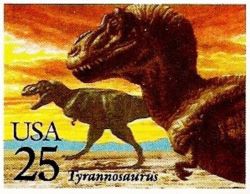
Image Copyright- US Postal Service
Tyrannosaurus Rex
| How big did it get? | One of the largest theropod dinosaurs, with lengths up to 40 feet and estimated weights exceeding 9 tons. |
| When did it live? | Late Cretaceous period, approximately 68 to 66 million years ago. |
| Where did it live? | Fossils found in North America, particularly in present-day Montana, Wyoming, and South Dakota.. |
| What did it eat? | Carnivorous, likely preying on a variety of large herbivorous dinosaurs. |
| Interesting facts? | T. rex is one of the most iconic dinosaurs, known for its powerful jaws, serrated teeth, and short, stubby arms. It is considered one of the apex predators of its time. |
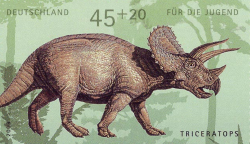
Triceratops
| How big did it get? | Approximately 9 meters (30 feet) in length and weighing up to 12 tons. |
| When did it live? | Late Cretaceous period, around 68 to 66 million years ago. |
| Where did it live? | Fossils found in North America, particularly in the western United States. |
| What did it eat? | Herbivorous, feeding on low-lying vegetation with its distinctive beak and teeth. |
| Interesting facts? | Triceratops is well-known for its three facial horns and frill, which likely served defensive and display purposes. It coexisted with and may have been preyed upon by T. rex. |
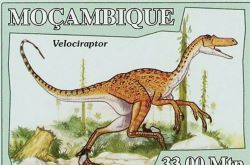
Velociraptor
| How big did it get? | Approximately 6 feet in length. |
| When did it live? | Late Cretaceous period, around 85 to 70 million years ago. |
| Where did it live? | Fossils found in Mongolia and China. |
| What did it eat? | Carnivorous, likely hunting in packs and preying on smaller animals. |
| Interesting facts? | Velociraptor was a small, agile predator with a distinctive sickle-shaped retractable claw on each foot. It played a significant role in the development of the "raptor" archetype in popular culture. |
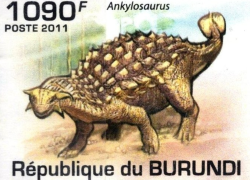
Ankylosaurus
| How big did it get? | Approximately 20 feet in length, heavily armored with a bony tail club. |
| When did it live? | Late Cretaceous period, around 68 to 66 million years ago. |
| Where did it live? | Fossils found in North America, specifically in present-day Montana, Wyoming, and Alberta. |
| What did it eat? | Herbivorous, using its beak to graze on vegetation. |
| Interesting facts? | Ankylosaurus was a heavily armored dinosaur with a unique tail club, possibly used for defense against predators. |
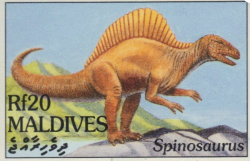
Spinosaurus
| How big did it get? | One of the largest known theropod dinosaurs, with estimated lengths up to 50-59 feet. |
| When did it live? | Cretaceous period, around 112 to 93 million years ago. |
| Where did it live? | Fossils found in North Africa, specifically in Egypt and Morocco. |
| What did it eat? | Carnivorous, likely preying on fish and other aquatic animals. |
| Interesting facts? | Spinosaurus is unique among theropods for its adaptations to a semi-aquatic lifestyle, featuring elongated jaws and potentially being a proficient swimmer. |
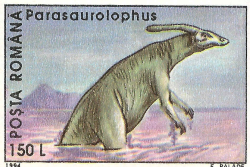
Parasaurolophus
| How big did it get? | Approximately 30 feet in length, with a distinctive hollow crest on its head. |
| When did it live? | Late Cretaceous period, around 76 to 73 million years ago. |
| Where did it live? | Fossils found in North America, particularly in present-day Alberta, Canada, and New Mexico, USA. |
| What did it eat? | Herbivorous, likely feeding on low-lying vegetation. |
| Interesting facts? | Parasaurolophus is recognized for its elaborate head crest, which may have been used for communication or thermoregulation. |
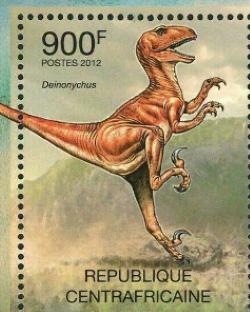
Deinonychus
| How big did it get? | Approximately 11 feet in length. |
| When did it live? | Early Cretaceous period, around 115 to 108 million years ago. |
| Where did it live? | Fossils found in North America, specifically in Montana, Utah, and Wyoming. |
| What did it eat? | Carnivorous, likely hunting in packs and preying on smaller dinosaurs. |
| Interesting facts? | Deinonychus is often considered a close relative to Velociraptor and is characterized by its sharp, curved claws and agile hunting behavior. These dinosuars were about the twice the size of the velociraptors. |
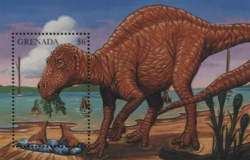
Maiasaura
| How big did it get? | Approximately 30 feet in length. |
| When did it live? | Late Cretaceous period, around 76 to 73 million years ago. |
| Where did it live? | Fossils found in North America, specifically in present-day Montana. |
| What did it eat? | Herbivorous, with a diet primarily consisting of vegetation, particularly ferns and conifers. |
| Interesting facts? | Maiasaura is known for its parental care, with evidence of nesting colonies and the presence of fossilized hatchlings suggesting nurturing behavior towards their young. |